Please note: At this stage, bitcoin mining can only make sense using dedicated ASIC hardware. Trying to do this on your computer or desktop GPU will probably just damage your hardware or shorten it’s lifetime, and run you up a large electricity bill. However, a number of altcoins allow for CPU or GPU mining, but the risks still remain
If you are new to bitcoin mining, the terminology about how you can get paid can be a little confusing. In this article, we explain what the Pay Per Share (PPS) reward system is, and how you can calculate your earnings.
Pay Per Share refers to a reward system used by bitcoin mining pools, where you are rewarded for your hashing power on a share basis. Bitcoin miners do a much speeded up version of the sha256 algorithm outlined here. Depending on the difficulty of the sum being done, bitcoin mining pools will pay a fixed sum for successfully completed hash. The more power you have, the more shares you can submit per second. For instance, the 650ghs our review rig when focused on one place will generate about 130 shares a second at the difficulty it is being assigned by the pool. Several million are submitted over the course of a mining run, and each of these receives a fixed payout.
The bitcoin difficulty adjusts approximately every two weeks, or every 2016 blocks based on the overall amount of hashing on the global network, so keep it generating blocks at a ten minute average interval. If loads of power comes on the network, the difficulty goes up, and if it drops, the difficulty will also drop.
So for PPS earners, with a fixed amount of hashing power, over time your earnings will drop if difficulty continues to increase, stretching out your return on investment. Each share is worth 1/current network difficulty, and I’ve outlined some stats below to let you see how it works using an example of 2 million shares submitted a day on a PPS rate.
| Difficulty | PPS BTC Rate | Shares/Day | Earnings/Day | Shares/30 day Month | Earnings/Month | € / 1 Bitcoin | Mining Earnings |
| 30,000,000,000 | 0.0000000000333 | 2,000,000 | 0.000067 | 60000000 | 0.002 | € 260.00 | € 0.52 |
| 40,000,000,000 | 0.0000000000250 | 2,000,000 | 0.000050 | 60000000 | 0.0015 | € 260.00 | € 0.39 |
| 50,000,000,000 | 0.0000000000200 | 2,000,000 | 0.000040 | 60000000 | 0.0012 | € 260.00 | € 0.31 |
| 60,000,000,000 | 0.0000000000167 | 2,000,000 | 0.000033 | 60000000 | 0.001 | € 260.00 | € 0.26 |
As the network difficulty goes up, some hardware becomes inefficient, and it’s removal in bulk from the network can cause temporary plateaus or minor drops in difficulty, but often as new hardware comes on board after, the difficulty will continue to increase. Click here for a very handy bitcoin calculator to work out earnings on your hardware.
So PPS gives people a fairly predictable pattern of earnings for their bitcoin mining activities, which they can multiply by the number of shares their hardware generates, and let you compare earnings side by side. We’ve reviewed several mining pools so far with BitAffNet, Discus Fish and Polmine all use this payout method. There is also the alternative payout method, PPLNS which other pools use, which can give more or less earnings than PPS.


